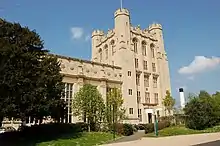Centre for Device Thermography and Reliability
The Centre for Device Thermography and Reliability is a research facility at the University of Bristol, a research university located in Bristol, United Kingdom.[2] Founded in 2001, by Professor Kuball the centre is engaged in thermal and reliability research of semiconductor devices, in particular for microwave and power electronic devices. It is housed in the H. H. Wills Physics Laboratory, a noted physics laboratory associated with the Physics department of the university.[3] CDTR is noted for developing an integrated Raman-IR thermography technique to probe self-heating in silicon, GaAs and other devices. This enables unique thermal analysis of semiconductor devices on a detailed level not possible before.[4] These techniques are critical in understanding the reliability of Compound semiconductor devices applicable in power and microwave devices and in the long term as a viable replacement for Silicon devices as it approaches the end of scaling.[5]
| Established | 2001 |
|---|---|
| Endowment | £2.6m[1](2012-13) |
| Director | Prof. Martin Kuball |
| Deputy Director | Prof. Michael Uren |
Academic staff | 18 |
Administrative staff | 3 |
| Location | , England, United Kingdom 51°27′23″N 02°36′16″W |
| Nickname | CDTR |
| Affiliations | University of Bristol |
| Website | CDTR Home Page |
The institute gets funding from various government and private sector sources, such as European Space Agency and Engineering and Physical Sciences Research Council.[6]
Solid State Device Research in University of Bristol
The H.H. Wills Physics Laboratory, named after Henry Herbert Wills, is the home of the department of Physics of the university. Former heads of department include Sir Charles Frank (crystal growth, liquid crystals) and Nobel Laureates C. F. Powell (whose discovery of the π meson marked the birth of modern particle physics), and Sir Nevill Mott. The Aharonov-Bohm effect and the Berry phase are also Bristol discoveries. The School carries out research in the fields of Astrophysics, Correlated Electron Systems, Micro and Nanostructural Materials, Nanophysics and Soft Matter, Particle Physics, Quantum Photonics and Theoretical Physics.[7] The School is a principal stakeholder in the University’s £11 million Centre for Nanoscience and Quantum Information and the £3 million Centre for Device Thermography and Reliability. The laboratory is one of the quietest laboratories in the world.[8][9]

Research
The CDTR carries out in research in the following areas.[10]
- Microwave and Power electronic devices
- Thermal management research
- Electronic Device Performance and Reliability
- Device Simulation
References
- "Annual Report and Financial Statements for financial year ended 31 July 2013" (PDF). Archived from the original (PDF) on 2014-01-12. Retrieved 2014-09-10.
- "Maps and Guides". The University precinct map. Retrieved 10 September 2014.
- The Sunday, Times. "University of Bristol". The Sunday Times. Retrieved 10 September 2014.
- Sarua, A (7 July 2008). "Raman-IR micro-thermography tool for reliability and failure analysis of electronic devices". Proc. Physical and Failure Analysis of Integrated Circuits, 2008.: 1–5. doi:10.1109/IPFA.2008.4588160. ISBN 978-1-4244-2039-1.
- Handy, Jim. "The End of Semiconductor Scaling". Forbes. Retrieved 16 September 2014.
- "Funding | School of Physics | University of Bristol".
- 2014, ARWU World Rankings. "University of Bristol". www.shanghairanking.com/. The Academic Ranking of World Universities. Retrieved 16 September 2014.CS1 maint: numeric names: authors list (link)
- "'Quietest building in the world' officially opens". Capita Symonds. Retrieved 8 November 2011.
- "Visiting the quietest building in the world". Institute of Physics. Retrieved 10 November 2011.
- "Research | School of Physics | University of Bristol".
